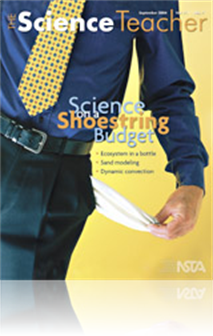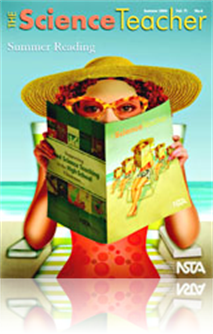All The Science Teacher resources
Journal Article
Earth science teaches know how frustrating it can be to spend hundreds of dollars on three-dimensional (3-D) models of Earth’s geologic features, only to use the models for a few class periods. To avoid emptying an already limited science budget, t...
Journal Article
Ask the Experts—September 2004
The experts address the following question in this month’s column: Why do geckos make sounds and why mostly at night?...
Journal Article
Typically, teachers use simple models that employ differences in temperature and density to help students visualize convection. However, most of these models are incomplete or merely hint at (instead of model) convective circulation. In order to make...
Journal Article
Every student should be provided with high quality teaches who provide high quality instruction in support of student learning and achievement. So then the question is, “How do we make that happen?” Basically, there are two strategies that teache...
Journal Article
Idea Bank: Roller Coaster Inquiry
This project, which centers on roller coaster design, engages students in learning about physics and activates their prior knowledge in an open-inquiry environment. The activity also gets students involved with inquiry and group work during the first...
Journal Article
Editor's Corner: May You Live in Interesting Times!
As the 2004-2005 began, science teachers were faced with unprecedented challenges. Limited budgets were stretched to the breaking point. The mandates of No Child Left Behind (NCLB), state and national standards, and high-stakes testing required teach...
Journal Article
For several decades, science teachers have used bottles for classroom projects designed to teach students about biology. A model terrarium enclosed in a glass bottle was described in the 1975 edition of Science and Children (Ochs and Brock 1975). S...
Journal Article
Many physics teachers have an unclear understanding of Bernoulli’s principle, particularly when the principle is applied to aerodynamic lift. Some teachers favor using Newton’s laws instead of Bernoulli’s principle to explain the physics behind...
Journal Article
Using microbiology activities in the classroom is an effective way for teachers to address National Standards in the life sciences. However, they could be too risky to implement due to the likelihood of cultivating human pathogens. In addition, makin...
Journal Article
Idea Bank: Modeling a Sinkhole
Limestone lies underneath approximately 15 percent of the United States. Fractures, cracks, and weaknesses develop due to Earth’s natural processes or manmade sources, resulting in structural change to the limestone. As a result, the formation of s...
Journal Article
The experts address the following questions in this month’s column: How do sunscreens work? Does baby oil really make you tan faster? Why do some people tan more than others or end up getting a bad sunburn after spending the same amount of time in ...
Journal Article
Teaching Science to the Visually Impaired
Science educators must address the needs of visually impaired students by making the appropriate accommodations in the laboratory and science classroom. This article provides practical strategies for engaging visually impaired students in science-rel...
Journal Article
Idea Bank: Got Milk? Do Biochemistry
Bacteria are very useful for introducing high school students to biochemical processes in the cell, including the hydrolysis of nutrients, the production of waste products, and changes in pH. All of this can be demonstrated to students using simple m...
Journal Article
As part of an ongoing environmental project and partnership with a local university, high school students monitor changes to Fossil Creek in Arizona. Components of the project include fish behavior studies, responses to fishing, water chemistry measu...



